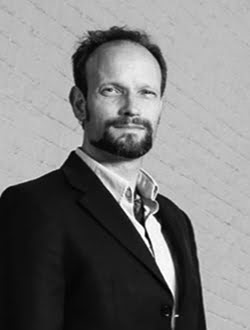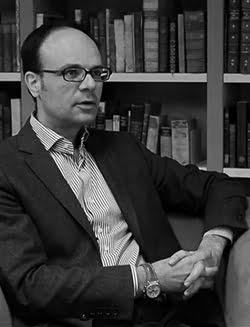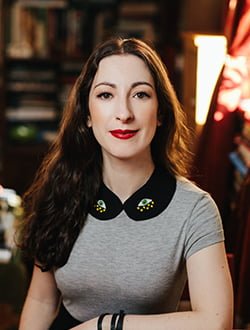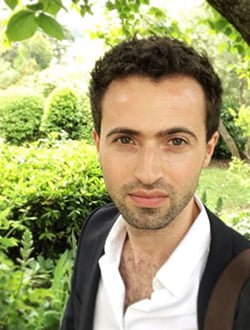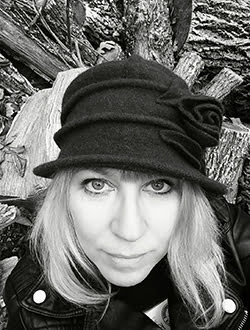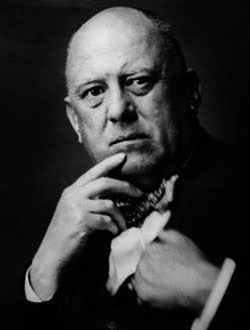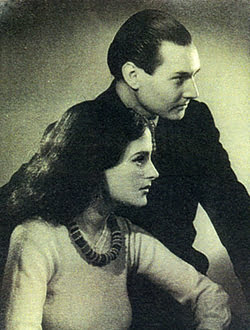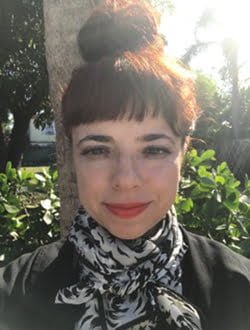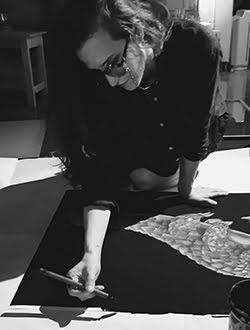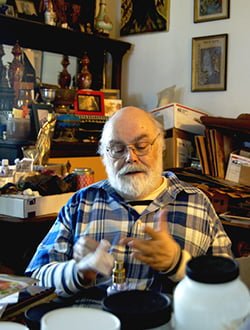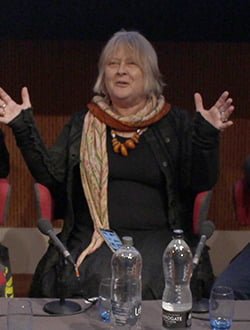
I:MAGE – Travelling with Unfamiliar Spirits
Curated by Robert Ansell and Livia Filotico
Cob Gallery, London
October 21st–November 2nd, 2014
OVERVIEW
I:MAGE 2014 developed the ideas initiated by the 2013 programme to deliver a multi-location interdisciplinary event over twelve days. Centred upon an exhibition of esoteric art curated by FULGUR at the Cob Gallery, London, the schedule included artist-led workshops and discussions, a day of lectures at the Warburg Institute, evening events, a live performance from the artist Mark Titchner, and the launch of the Black Mirror Network publishing series with Volume 0 – territory.
I:MAGE 2014 was also the first to support an artist in residence, Elaine Knight, who collected words from participants to create a collaborative community-led text work.
One of the highlights of I:MAGE 2014 was a series of works loaned by Steffi Grant: Austin Osman Spare’s Black Eagle, Steffi Grant’s Shadows of the Old Ones, Kenneth Grant’s Desmodus and Aleister Crowley’s LAM. These had never been exhibited together previously, and furthermore, LAM had not been seen in public since it was exhibited by Crowley’s New York studio in 1917.
The texts below were published in the I:MAGE 2014 catalogue.
INTRODUCTION
The English word evidence is based on the Latin verb videre: to see. Familiar phrases such as seeing is believing or the assurance that something must be true because ‘I saw it with my own eyes’ are everywhere. Such observations and many others all bear witness to a well-established European connection between seeing and truth. 1
Today we live partly in a virtual world. We communicate through invisible channels, spending invisible money. Many of us even have an invisible self, countless fragments of actions scattered across a network of computers. And yet despite this intangible realm there are physical consequences – products through our letterbox and the joy of speaking to distant family. Material consequences obtained through immaterial means. It is perhaps no surprise then that this tension between the visible and the invisible – this ‘virtual crisis’ – would spark an interest in exploring the boundary further.
One of the ways for contemporary art to tackle these issues often produces confusion between notions of invisibility and emptiness. To mystery and curiosity it opposes intellectual rigour. The number of empty rooms we have endured is perhaps incalculable. White cubes devoid of art, feeling and mystery. So it is perhaps no surprise that ideas of spirituality in contemporary art seem increasingly relevant – and with them notions of spirit-entities.
The idea that feelings are embodied in god-forms and spirit-entities is hardly new in esoteric traditions. In the 15th and 16th century the spirits of the planets were assumed to influence moods, passions and emotions. Agrippa tells us that ‘wise men conceive it in no way irrational […] to draw new virtues from above’ (Agrippa, Book I). This implies a relationship between spirit and practitioners that is based on experiencing the effect of feelings on the body. Later still, in the 19th century, spiritualists termed ‘drawing mediums’ channelled artworks that brought attention to issues of remembrance, nostalgia, empathy and generational links. James Jackson Jarves advises us to understand ‘art as a vehicle of feelings about human destiny and not simply an instrument of routine aesthetic enjoyments’. 2
Thus, the concept of spirit-entities allows us to experience through the body again, and so re-introduces the idea of feelings to contemporary art. For the most part, spirits are felt or made contact’ with – tact being one of the original meanings of ‘to feel’ – rather than seen. Many of the artists exhibiting here note this,
I feel a nervousness arising accompanied by a feeling of immanence. Then there is a turning inwards and a disconnection from external perceptions. It feels like an ongoing initiation in perfect trust. [residue]
Thinking, looking and analysing will not work when faced with a canvas by Residue, Anne Crossey or Francesco Parisi. These works seem embedded in the here and now and the artist who experiences them can only do justice to it by capturing the immediacy of the moment. And as a viewer, we cannot expect to gain from these works unless we are willing to let go of any intellectual pretence. We must surrender, just as the artist has.
The idea of communication with spirits also offers another perspective for the world of fine art; it provides the means to return to subjective rather than abstract thoughts.
…[aesthetic] methods should be supplemented by the mysterious test of feeling; which takes cognizance of the sentiment of an artist, his absolute individuality, by which he is himself , and none other 3
In this guise, the artist becomes a singular translator. From spirit to artist, the whispered vision is intimate, exclusive. In turn, the artist reveals to us his deepest secrets, fears and ecstasies. Thus through otherness the artist discovers his sense of ‘I’ – an idea often lost within fine art.
Here then, once again, we find the artist as magician, a conjurer of new worlds.
Artist, you are a priest: Art is the great mystery and, if your effort results in a masterpiece, a ray of divinity will descend as on an altar. Artist, you are a king: Art is the true empire, if your hand draws a perfect line, the cherubim themselves will descend to revel in their reflection. Spiritual design, a line of the soul, form of understanding, you make our dreams flesh. Artist, you are a mage: Art is the great mystery, it only proves our immortality. 4
So with these ideas in mind we are delighted to introduce I:MAGE 2014, a two week festival of art, lectures, talks, performances and publications. It is intended as a focus for ideas surrounding the relationship between artists and spirit-entities. The exhibition itself offers over 65 works from a select group of international artists that display a great diversity of approach. To aid the visitor we have therefore created three categories – the social, the spatial and the personal – in the hope that they might help us explore ideas of embodiment, feelings and individuality. The catalogue you are holding is also arranged on this basis.
Robert Ansell & Livia Filotico
October 11th 2014
NOTES
1. Maurice Bloch, ‘Truth and Sight: Generalizing without Universalizing’, in Journal of the Royal Anthropological Institute, 2008.
2. Jarves quoted in Colbert, Charles, Haunted Visions, Spiritualism and American Art (Philadelphia : Penn Press, 2011) p. 185.
3. Colbert, p. 217.
4. Joseph Péladan, L’Art Idealiste et Mystique, 1894. Translated by Sasha Chaitow, http://peladan.org/?p=1407 (accessed 11th October 2014).
FULL PROGRAMME
JESSE BRANSFORD
The Colours of Western Esotericism
October 22nd, Cob Gallery
Colour has enormous potential for facilitating lateral thinking and free association. It is these qualities that make it such a powerful concept in esoteric thought, theory and practice. As a history of the idea of colours from antiquity to the present, the workshop will rely primarily on colour ‘systems’ articulated in Agrippa’s Three Books of Occult Philosophy and the work of the Hermetic Order of the Golden Dawn. As a hands on practium, the workshop will weave participants down a path towards an understanding of colour that will enable novel constructions and enhance one’s visual and/or esoteric practice.
JESSE BRANSFORD and ROBERT WALLIS
Seiðr & The Veil of Dreams
October 23rd, Cob Gallery
Between April and October 2014 artist Jesse Bransford worked with Max Razdow on The Veil of Dreams, an I:MAGE art project involving dream synchronicities, Seidr shamanistic practices and an initiatory journey to the Icelandic geothermal pools. Tonight, he will talk about the spirits he encountered and show photo documentation of this incredible magical working.
In the second part of the evening, Jesse Bransford will be joined by Prof. Robert Wallis and I:MAGE co-curator Livia Filotico for a panel discussion on the role of dream visions for art, magic and creativity. Questions and insights from the audience will follow.
I:MAGE at the Warburg Institute
October 25th, Warburg Institute
This one-day of lectures aims to offer an insight into the emerging category of esoteric art by focusing on what has been defined as one of its key aspects – the engagement between artists and spirit entities and what this means in terms of artistic expression. The I:MAGE day of lectures will take place at the Warburg Institute. Leading scholars in the field will present original research on the intersection between artistic currents such as Surrealism, modernism and abstraction and esoteric movements such as witchcraft, Spiritualism, the Hermetic Order of the Golden Dawn and Theosophy. By exploring a range of artists with different historical contexts and means of expression we hope to inspire artists and researchers working with these themes today and to develop the framework upon which further research, both historical and contemporary, can be carried out. The lecture series will be followed by an evening reception at Treadwell’s Bookshop the leading gathering point for Esotericism in London.
ROBERT SHEHU-ANSELL
Introductory Remarks
10.15–10.30am
MARCO PASI
The Curious Case of Georgiana Houghton’s Spirits
10.30–11.30am
ABSTRACT
This paper will focus on Georgiana Houghton (1814-1884) a British spirit artist whose story presents many similarities with Swedish painter Hilma af Klint’s (1862-1944) but has undeservedly received much less attention. After completing her artist training in the early 1860s Houghton became interested in spiritualism and became herself a medium. She then began to produce a series of drawings under the direct influence of spiritual entities. In 1871 she held her first and only large exhibition in a London gallery. Contrary to her expectations, the exhibition was largely unsuccessful and nearly bankrupted her. It’s easy for us to see why: her works were largely ahead of their time as they were almost exclusively abstract. In this lecture our speaker will argue that reconsidering Houghton’s work poses some important questions for the study of modern art in relation to western esotericism.
AMY HALE
Invoking Colour and Form as Spirit Entities
11.30–12.30am
ABSTRACT
In 1911 Wassily Kandinsky’s Concerning the Spiritual in Art presented to the emerging modern art world the not-so-modern ideas that form and color have deep resonances and other plane existences which signify and also literally create multiple realities for both artist and audience. While these principles feature in esoteric art from many parts of the world and throughout history, the idea of invoking colour and form as entities in and of themselves within a “fine art” context, creates an interesting condition of feedback and interaction between esotericists and artists, and may provide yet another way in which we can more widely contemplate the parameters of the category of “esoteric art”. Here, we will briefly consider the historical realms of colour and form in mandalas, platonic solids and aniconic representations of deity, and then look at the impact of these ideas in the world of modern and esoteric art to help reconsider the interconnected fields of art and practice.
GARY LACHMAN
Communicating with Higher Spirits: Hilma Af Klint
1.00–2.00pm
ABSTRACT
Although until recently practically unknown, the Swedish artist Hilma af Klint was, with Wassilly Kandinsky and Frantisek Kupka, an early pioneer of abstract art. And like Kandinsky, Kupka, Mondrian, Malevich and others, her work was profoundly influenced by her encounters with Madame Blavatsky’s Theosophy, Rudolf Steiner’s Anthroposophy, and Spiritualism. In 1892, with ‘The Five’, a group of similarly mystically inclined women artists, Klint engaged in a series of paintings depicting a metaphysical philosophy based on messages coming from ‘higher spirits.’ Klint developed her metaphysical art throughout her life, but her abstract paintings were not exhibited during her lifetime, and it is only in recent years that they have been available to the public. Gary Lahcman spoke about the art and life of Klint at the Moderna Musset in Stockholm in 2012, and at the Louisiana Museum of Modern Art near Copenhagen in 2014.
SUSAN ABERTH
Leonora Carrington: Invitation, Invocation and Manifestation
2.00–3.00pm
ABSTRACT
From her first widely exhibited work, Inn of the Dawn Horse (Self Portrait), executed while only twenty-one in 1938, the artist Leonora Carrington used the act of painting to invoke and harness unseen forces. Through the depiction of communion with and between animals, the presentation of altars containing ritual sacrifices, or the drawing of magic circles and other geometric patterns, Carrington’s work often serves as a perpetual summoning of the divine to manifest. Celtic goddesses, spirits of the departed, the Sidhe of the Tuatha Dé Danann, and other chthonic and ancient entities are called forth to serve unknown purposes or perhaps simply to demonstrate their continued existence and intervention in our supposedly secular times. This talk will focus on works in various media that best illustrate this aspect of Carrington’s oeuvre.
DANIEL ZAMANI
In Search of Counter-Enchantment: Totemic Powers and the Materiality of Magic in Victor Brauner
3.30–4.30pm
ABSTRACT
This paper explores the esoteric ramifications of Victor Brauner’s paintings and objects from the early to the late 1940s, undoubtedly one of the most iconic instances of magic art in the context of the Surrealist avant-garde. As a Jewish foreigner with Communist leanings, Brauner was in particular danger after the occupation of France by Nazi Germany. Unable to obtain a visa to the United States or Mexico, he was forced to spend the war years in hiding. This experience of complete isolation and fear of being discovered and deported led to an intensive study of the Jewish Kabbalistic tradition. Although Brauner’s objects from this period were not produced for aesthetic contemplation and despite his avid identification with the figure of a powerful artist-magician, these works have been consistently read through a metaphoric lens, ultimately eclipsing their primary function as totemic objects associated with the power of counter-enchantment. My paper proposes a new reading of these fascinating artefacts which, I argue, ultimately eclipse any possible distinction between artistic objects and functioning talismans. Particular emphasis will be placed on Brauner’s distinctive use of magic materials, knowledge of which was garnered from an impressively detailed immersion in esoteric literature aimed at occult practitioners.
PAM GROSSMAN
Witch Pictures: Female Magic and Transgression in Western Art
4.30–5.30pm
ABSTRACT
The image of the witch as we know it first appeared in visual culture in the late 15th century, and became a popular subject in artwork in the years that followed through today. Artists as varied as Durer, Fuseli, Goya, and Blake utilised the archetype of magical – and often malevolent – women to titillate their patrons or reflect their own anxiety about female bodies and societal roles, often resulting in works that were either grotesque or beguilingly glamorous. But what happens when witches themselves wield the brush? In the mid-19th century, a family tree of female visionary artists began to take root. Deeply entrenched in esoteric studies, and often engaging in their own ritual practices, these women began creating works that used their own metaphysical experiences as inspiration, thus becoming their own muses. In this richly illustrated presentation, Pam Grossman will explore the witchy women artists of Abstraction, Surrealism, Modernism – and movements that have yet to be classified – and shine a light in the corners of art history where craft and Craft are one and the same.
End of Warburg Lectures
ELIZABETH INSOGNA interviewed by CAROLINE WISE
Goddess, Speak
October 28th, Cob Gallery
Liz Insogna is a New York based artist who after 10 years in the fine art world has more recently began working with the Goddess through the self-initiatory path of art. Today, Caroline Wise interviews her about her first magical experiences, about art as a magical practice and about the changes in perspective which occur after one begins to look at the world through magical symbols. Liz is currently conducting her first cycle of Goddess invocations and documenting her experiences. Several of her paintings will be exhibited at I:MAGE. Caroline Wise Caroline has been involved with the Goddess movement for 30 years, and works in esoteric publishing.
The interview will be followed by a workshop conducted by Caroline Wise, where participants are invited to create votives.
MARK TITCHNER, JUDITH NOBLE and DOMINIC SHEPHERD
Launch Party for Black Mirror 0: territory
October 30th, Cob Gallery
Fulgur Press and University Arts Bournemouth invite you to the first official event for Black Mirror, a research network exploring the relationship between modernism, contemporary art and the occult. Tonight we launch territory, the first volume produced by the network and published by Fulgur. We will celebrate with a performance by Mark Titchner entitled The Fool.
Contributors to this volume include Massimo Introvigne, Gavin Parkinson and Ulli Seegers amongst others. Speeches from the network coordinators begin at 7:30pm. Performance begins at 8pm.
DAVID GRAEBER
Embodied Spirits and Fetishes
November 1st, Cob Gallery
In tonight’s talk our speaker will explore the relationship between creativity, magic, nature and spirits, and introduce us to the concept of the fetish from an anthropological perspective. The lecture will be followed by a closing party and a ritual art installation.
CHIARA AMBROSIO and others
Abraxas Special Issue No.2 – Luminous Screen
November 2nd, Horse Hospital
Join us for the launch of Luminous Screen, Abraxas Journal’s second special issue dedicated to the occult in films. Following the theme of I:MAGE, tonight’s event will be focused on spirit possession and cinema. The programme includes the screening of Kelly Hayes’ evocative documentary on Afro-Brazilian religions Slaves of the Saints, a talk by anthropologist and film maker Chiara Ambrosio on southern Italian possession phenomena and a discussion panel on possession in western esotericism hosted by Stranger Attractor Press founder, Mark Pilkington.
PROGRAMME SYNOPSIS
October 21st
I:MAGE Opening Reception
Cob Gallery, 6pm – 9:30pm
October 22nd
Jesse Bransford
The Colours of Western Esotericism
Workshop
Cob Gallery, 7:30pm – 9:30pm
Thursday October 23rd
Jesse Bransford and Max Razdow
The Veil of Dreams
Artist Lecture
Cob Gallery, 7:30pm – 9pm
October 25th
I:MAGE at the Warburg Institute
Warburg Institute, 10am – 6pm
October 28th
Caroline Wise in conversation with Liz Insogna
Goddess, Speak
Artist Discussion
Cob Gallery, 7:30pm – 9pm
October 30th
Mark Titchner
Black Mirror Volume 0
Launch Party and Performance
Cob Gallery, 7pm – 10pm
November 1st
David Graeber
Embodied Spirits and Fetishes
Lecture
Cob Gallery, 7:30pm – 9pm
November 2nd
Abraxas Special Issue No. 2
Luminous Screen
Launch Party and Screenings
Horse Hospital, 7pm-10pm
CATALOGUE
I:MAGE
Travelling with Unfamiliar Spirits
Softback
21cm x 21cm
96 pages
74 colour images | 4 black and white
English Text


